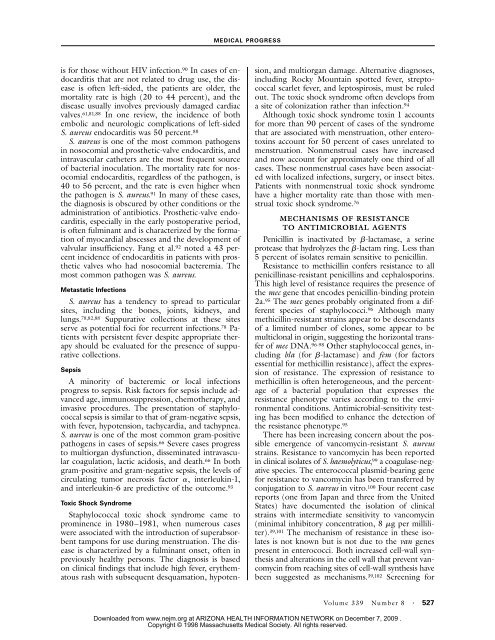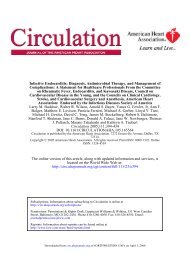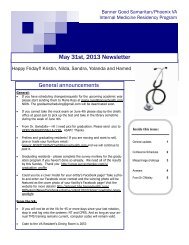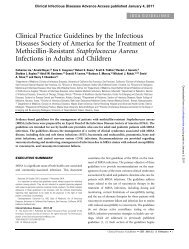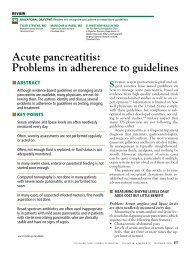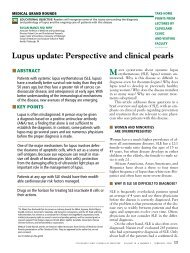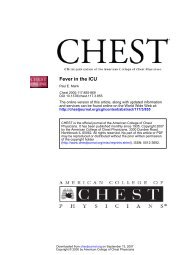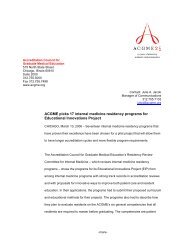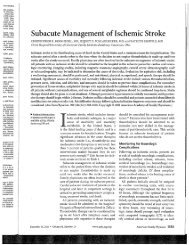082098 Staphylococcus aureus Infections - Goodsamim.com
082098 Staphylococcus aureus Infections - Goodsamim.com
082098 Staphylococcus aureus Infections - Goodsamim.com
Create successful ePaper yourself
Turn your PDF publications into a flip-book with our unique Google optimized e-Paper software.
MEDICAL PROGRESS<br />
is for those without HIV infection. 90 In cases of endocarditis<br />
that are not related to drug use, the disease<br />
is often left-sided, the patients are older, the<br />
mortality rate is high (20 to 44 percent), and the<br />
disease usually involves previously damaged cardiac<br />
valves. 61,81,88 In one review, the incidence of both<br />
embolic and neurologic <strong>com</strong>plications of left-sided<br />
S. <strong>aureus</strong> endocarditis was 50 percent. 88<br />
S. <strong>aureus</strong> is one of the most <strong>com</strong>mon pathogens<br />
in noso<strong>com</strong>ial and prosthetic-valve endocarditis, and<br />
intravascular catheters are the most frequent source<br />
of bacterial inoculation. The mortality rate for noso<strong>com</strong>ial<br />
endocarditis, regardless of the pathogen, is<br />
40 to 56 percent, and the rate is even higher when<br />
the pathogen is S. <strong>aureus</strong>. 91 In many of these cases,<br />
the diagnosis is obscured by other conditions or the<br />
administration of antibiotics. Prosthetic-valve endocarditis,<br />
especially in the early postoperative period,<br />
is often fulminant and is characterized by the formation<br />
of myocardial abscesses and the development of<br />
valvular insufficiency. Fang et al. 92 noted a 43 percent<br />
incidence of endocarditis in patients with prosthetic<br />
valves who had noso<strong>com</strong>ial bacteremia. The<br />
most <strong>com</strong>mon pathogen was S. <strong>aureus</strong>.<br />
Metastatic <strong>Infections</strong><br />
S. <strong>aureus</strong> has a tendency to spread to particular<br />
sites, including the bones, joints, kidneys, and<br />
lungs. 78,82,88 Suppurative collections at these sites<br />
serve as potential foci for recurrent infections. 78 Patients<br />
with persistent fever despite appropriate therapy<br />
should be evaluated for the presence of suppurative<br />
collections.<br />
Sepsis<br />
A minority of bacteremic or local infections<br />
progress to sepsis. Risk factors for sepsis include advanced<br />
age, immunosuppression, chemotherapy, and<br />
invasive procedures. The presentation of staphylococcal<br />
sepsis is similar to that of gram-negative sepsis,<br />
with fever, hypotension, tachycardia, and tachypnea.<br />
S. <strong>aureus</strong> is one of the most <strong>com</strong>mon gram-positive<br />
pathogens in cases of sepsis. 66 Severe cases progress<br />
to multiorgan dysfunction, disseminated intravascular<br />
coagulation, lactic acidosis, and death. 66 In both<br />
gram-positive and gram-negative sepsis, the levels of<br />
circulating tumor necrosis factor a, interleukin-1,<br />
and interleukin-6 are predictive of the out<strong>com</strong>e. 93<br />
Toxic Shock Syndrome<br />
Staphylococcal toxic shock syndrome came to<br />
prominence in 1980–1981, when numerous cases<br />
were associated with the introduction of superabsorbent<br />
tampons for use during menstruation. The disease<br />
is characterized by a fulminant onset, often in<br />
previously healthy persons. The diagnosis is based<br />
on clinical findings that include high fever, erythematous<br />
rash with subsequent desquamation, hypotension,<br />
and multiorgan damage. Alternative diagnoses,<br />
including Rocky Mountain spotted fever, streptococcal<br />
scarlet fever, and leptospirosis, must be ruled<br />
out. The toxic shock syndrome often develops from<br />
a site of colonization rather than infection. 94<br />
Although toxic shock syndrome toxin 1 accounts<br />
for more than 90 percent of cases of the syndrome<br />
that are associated with menstruation, other enterotoxins<br />
account for 50 percent of cases unrelated to<br />
menstruation. Nonmenstrual cases have increased<br />
and now account for approximately one third of all<br />
cases. These nonmenstrual cases have been associated<br />
with localized infections, surgery, or insect bites.<br />
Patients with nonmenstrual toxic shock syndrome<br />
have a higher mortality rate than those with menstrual<br />
toxic shock syndrome. 76<br />
MECHANISMS OF RESISTANCE<br />
TO ANTIMICROBIAL AGENTS<br />
Penicillin is inactivated by b-lactamase, a serine<br />
protease that hydrolyzes the b-lactam ring. Less than<br />
5 percent of isolates remain sensitive to penicillin.<br />
Resistance to methicillin confers resistance to all<br />
penicillinase-resistant penicillins and cephalosporins.<br />
This high level of resistance requires the presence of<br />
the mec gene that encodes penicillin-binding protein<br />
2a. 95 The mec genes probably originated from a different<br />
species of staphylococci. 96 Although many<br />
methicillin-resistant strains appear to be descendants<br />
of a limited number of clones, some appear to be<br />
multiclonal in origin, suggesting the horizontal transfer<br />
of mec DNA. 96-98 Other staphylococcal genes, including<br />
bla (for b-lactamase) and fem (for factors<br />
essential for methicillin resistance), affect the expression<br />
of resistance. The expression of resistance to<br />
methicillin is often heterogeneous, and the percentage<br />
of a bacterial population that expresses the<br />
resistance phenotype varies according to the environmental<br />
conditions. Antimicrobial-sensitivity testing<br />
has been modified to enhance the detection of<br />
the resistance phenotype. 95<br />
There has been increasing concern about the possible<br />
emergence of van<strong>com</strong>ycin-resistant S. <strong>aureus</strong><br />
strains. Resistance to van<strong>com</strong>ycin has been reported<br />
in clinical isolates of S. haemolyticus, 99 a coagulase-negative<br />
species. The enterococcal plasmid-bearing gene<br />
for resistance to van<strong>com</strong>ycin has been transferred by<br />
conjugation to S. <strong>aureus</strong> in vitro. 100 Four recent case<br />
reports (one from Japan and three from the United<br />
States) have documented the isolation of clinical<br />
strains with intermediate sensitivity to van<strong>com</strong>ycin<br />
(minimal inhibitory concentration, 8 mg per milliliter).<br />
39,101 The mechanism of resistance in these isolates<br />
is not known but is not due to the van genes<br />
present in enterococci. Both increased cell-wall synthesis<br />
and alterations in the cell wall that prevent van<strong>com</strong>ycin<br />
from reaching sites of cell-wall synthesis have<br />
been suggested as mechanisms. 39,102 Screening for<br />
Volume 339 Number 8 · 527<br />
Downloaded from www.nejm.org at ARIZONA HEALTH INFORMATION NETWORK on December 7, 2009 .<br />
Copyright © 1998 Massachusetts Medical Society. All rights reserved.


